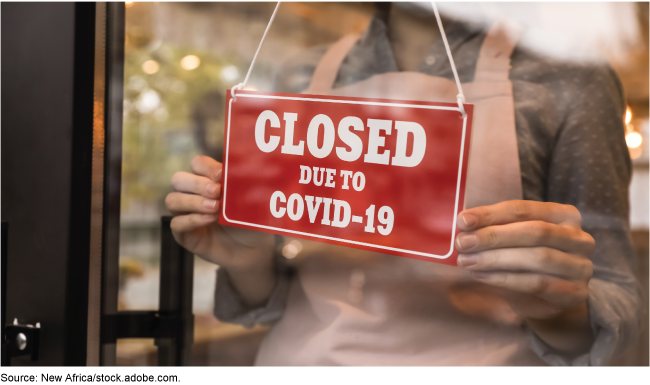Pandemic Risk: Federal Insurance Approaches Would Entail Costs to Taxpayers and Businesses Might Not Participate
Fast Facts
During the COVID-19 pandemic, some businesses used "business interruption coverage" to recoup losses, but insurers generally didn't pay pandemic-related claims. Many insurers have since added virus exclusions or removed previously available virus coverage.
We looked at whether the government could make pandemic insurance available to businesses. But the government would assume most or all risk. And it would be difficult to provide easily available and affordable coverage, primarily due to potentially large, widespread, and infrequent losses. While still costly, other emergency programs could be improved in advance of a future pandemic.

Highlights
What GAO Found
Private insurance played a limited role in addressing business losses from the COVID-19 pandemic. Some businesses turned to business interruption coverage to recoup losses. But insurers generally did not pay pandemic-related claims, because nearly all policies required physical damage to property. Insurers paid some pandemic-related claims in other property/casualty lines, including event cancellation and workers' compensation. Many insurers since have reduced their exposure to pandemic risk, primarily by adding physical damage requirements or virus exclusions or removing previously available virus coverage. Actuaries, insurance experts, insurers, and reinsurers generally agree pandemic risk—which involves potentially large, widespread, and difficult-to-predict losses—is largely uninsurable because it does not meet key insurability criteria.
In a potential federal pandemic insurance program, the government could (1) share risk with insurers or (2) assume all the risk, with insurers acting as administrators. Either approach could have benefits but also likely would face challenges in efficiently providing widespread, affordable coverage to businesses and achieving other desired policy goals.
- Risk-sharing could help reduce federal fiscal exposure and promote a larger private market for pandemic insurance. However, stakeholders agreed that given the magnitude of potential losses (estimated at more than $1 trillion based on the experience with COVID-19), insurers might be able to assume only a small share of the risk.
- Both approaches could make premiums affordable, but doing so likely would require large subsidies or financial assistance to businesses. While some businesses might buy coverage, others might forgo coverage, because they believed another pandemic would not happen soon or would expect other government assistance if it did.
- Both approaches could promote risk mitigation and leverage insurers' claims-processing expertise. But insurers told GAO that processing millions of claims in a short time could be costly and challenging for the industry.
Given these potential difficulties, Congress also could consider other (noninsurance) responses to the next pandemic, as it did in response to COVID-19. These options (such as a program to help businesses pay operating expenses) could be costly but reach millions of businesses quickly. But distributing assistance quickly without proper controls could leave programs at risk of improper payments and fraud.
Experiences of COVID-19 emergency assistance programs in the United States and other nations provide important insights on how the federal government could improve its response to future pandemics. For instance, the government could share risk or program costs with private entities such as businesses or banks, implement measures to prevent improper payments and fraud (as GAO recommended in multiple reports), and proactively plan for the next pandemic to reduce uncertainty.
Why GAO Did This Study
Businesses across the United States experienced disruptions, declines in demand, and mandated closures during the COVID-19 pandemic. Emergency relief programs enacted in 2020 and 2021 provided about $4.6 trillion for pandemic response and recovery, with about $1.2 trillion going to small businesses in the form of loans and grants. The potential for very large losses raises the question of what role insurers and the federal government might play in a future pandemic.
The CARES Act includes a provision for GAO to monitor federal efforts related to COVID-19. This report examines (1) the role insurance played addressing pandemic business losses, (2) benefits and challenges of federal insurance approaches for addressing such losses, and (3) benefits and challenges of federal noninsurance approaches for addressing such losses.
GAO analyzed information on insurance claims and reviewed criteria for insurability, proposals for federal pandemic insurance programs, and related academic and industry studies. To identify and obtain views on the benefits and challenges of federal insurance and noninsurance approaches, GAO reviewed academic and other studies, including GAO reports. GAO also held two panel discussions and multiple interviews with insurance industry participants and experts, among others.
For more information, contact Alicia Puente Cackley at (202) 512-8678 or cackleya@gao.gov.
